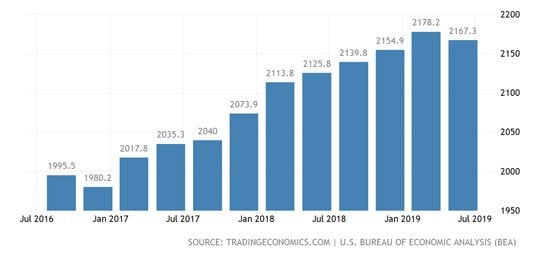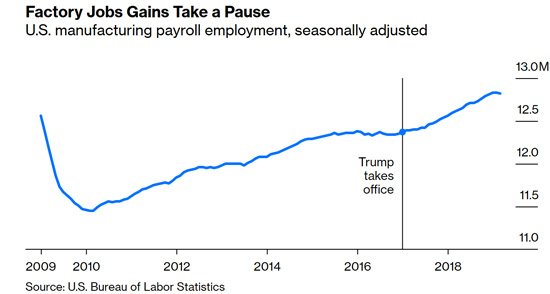Some major media outlets are trying to plant in your head that a "manufacturing recession" in the United States will sink the economy and the stock market.
A New York Times headline from this summer pushed the idea that a manufacturing recession will infect the economy: "U.S. Manufacturing Slowed in August in Latest Sign of Economic Weakness."
The Los Angeles Times got on board shortly after, in October: "Manufacturing Is Now Officially in Recession, Despite Trump's Vow to Boost Economy."
CBS then upped the fearmongering, confirming the manufacturing recession as a fact and making it sound viral: "U.S. Manufacturing Is in a Recession. What Does That Mean for the Rest of the Country?"
The problem is that it's all fake news. It's another narrative created by the media to scare you. Believing it can distract you from what's really going on - and stop you from making money.
That's why I'm going to show you the real story - and give you two stocks to buy to keep you away from the "noise" and hand you profits in 2020... [mmpazkzone name="in-story" network="9794" site="307044" id="137008" type="4"]
These Are Hardly "Recession" Numbers...
Sure enough, by one measure, manufacturing has been slipping over the last four months. But by another measure, it's been picking up - and showed its strongest reading over the last seven months in November.
According to the Institute for Supply Management (ISM) Purchasing Managers Index (PMI) "survey" (which tallies respondents' answers into a number where 50 is the neutral line, above which constitutes growth, and below which constitutes contraction), the PMI's been below 50 for the last four months.
November's number came in at 48.1, and October's was 48.3. September was 47.8, and back in August, it was 49.1.
December's tally isn't in yet, but analysts are expecting it to get back close to or above 50.
For all of 2019, the average through November is 51.8. The low month was September's 47.8 reading, and the high month was January's 56.6 mark.
Another gauge of manufacturing, the Markit Group's PMI measure, came in at 52.6 for November, which is 2.5% higher than October's 51.3 measure and was the "strongest reading in seven months," according to Markit.
However, the media chooses to report ISM PMI numbers over Markit's PMI numbers. These PMI numbers are never reported by mainstream outlets because the media wants to paint a doom-and-gloom future and scare you.
What's more patently fake is attaching the "recession" moniker to manufacturing.
A recession is defined as two consecutive quarters of negative GDP growth, meaning the country's gross domestic product is contracting - as in not growing at all - with minus signs in front of numbers.
Even if we assume manufacturing growth is measured the same way GDP growth is measured (which it isn't), we'd have to see two consecutive quarters (six months in a row) of negative growth. It's not slowing growth, but negative growth, as in a true contraction, that counts.
The ISM's PMI numbers have been below 50 for the last four months, and that's not a recession, even by the media's twisted definition.
Where the Media and Fed Go Their Separate Ways
The Federal Reserve has its own ways of measuring manufacturing.
YiLi Chien, Senior Economist, and Paul Morris, Research Associate at the Federal Reserve Bank of St. Louis, asked the following rhetorical question in the Bank's "On the Economy Blog": "Is U.S. Manufacturing Really Declining?"
They acknowledge, "A popular narrative over the past decade has been U.S. manufacturing's precipitous decline."
But they show, despite marked downtrends in manufacturing as a share of employment in the country and manufacturing as a share of nominal GDP, the "numbers exaggerate manufacturing's decline."
"To see why," they explain, "we need to measure the manufacturing sector's share of real GDP."
Their research reveals:
"The total value of goods produced is equal to the price multiplied by the quantity of goods produced. Removing the price effects from nominal GDP gives us real GDP, so changes in real GDP are the result of changes in the quantity produced. Thus, we can measure how the manufacturing sector's output has changed over time."
And continues, saying:
"The decline in manufacturing's share of nominal GDP over time thus must be because of changes in prices. Since 1947, the price level for the overall economy has grown 3.2 percent per year on average, while prices for manufacturing have grown just 2.2 percent per year.
"This implies that nominal GDP for the entire economy has outgrown manufacturing GDP largely because the overall price level has increased faster than the manufacturing price level, and not because the manufacturing sector has produced less relative to the rest of the economy.
"This quick inspection of the data indicates that manufacturing in the U.S. has not suffered a significant decline. Rather, manufacturing's roughly constant share of real GDP and declining employment share indicate an increase in productivity of the manufacturing sector relative to the overall economy. This is likely because of automation.
"With advanced tools such as robotics to handle tasks that were previously completed by employees, the average employee is able to produce more now than in years past. Thus, firms don't need to hire as many workers to produce the same amount of output."
According to the U.S. Bureau of Economic Analysis (BEA) - and shown in the chart below - even though "GDP from manufacturing" in the United States decreased to $216.73 trillion in the second quarter of 2019 from $217.82 trillion in the first quarter of 2019, manufacturing is historically strong as a contributor to overall GDP.
GDP from manufacturing in the United States averaged $199.03 trillion from 2005 until 2019, reaching an all-time high of $217.82 trillion in the first quarter of 2019 and a record low of $179.86 trillion in the first quarter of 2009.

How They Keep It All Under Wraps
The media's fake manufacturing recession narrative will never cheer on manufacturing as a contributor to positive GDP growth, because it's the truth.
Manufacturing job growth is another positive for the economy that's not being reported.
The fake news media was hoping to start headlining how manufacturing jobs growth is declining, instead of the accelerated growth in manufacturing jobs seen since U.S. President Donald Trump took office.
But they can't do that after the most recent employment numbers just showed 266,000 new jobs were created in November, with 54,000 of those being in manufacturing.
Yes, manufacturing jobs growth paused, but it's still growing.
Good luck finding a negative headline on that.

Creating more manufacturing jobs is a good sign. That's why the media's not reporting it.
Despite the disappearance in the past few years of what had long been a big hourly wage premium for workers in durable-goods manufacturing over other private-sector workers, manufacturing jobs have remained better-than-average jobs, especially for those without college degrees. And it comes with longer, more reliable hours and more generous benefits than most service work.
Everyone knows President Trump takes credit for the strong economy and for the record-breaking stock market. The country's seen a huge uptick in manufacturing under the Trump administration, but the media is knocking manufacturing because they know they can, and the president can't claim victory in manufacturing just yet, since a trade deal with China hasn't been finalized yet.
Attacking manufacturing is the fake news media's way of sabotaging the president's reelection prospects.
By fearmongering, the Trump-hating media hope to undermine consumer confidence and investor confidence.
If consumers pull back on spending, they could turn the economy down.
If investors sell stocks out of fear that a "manufacturing recession" could infect the economy and the stock market, they could turn the soaring stock market upside down.
They're trying to scare the American public. And that's the only scary thing out there.
The economy's growing, and the stock market's making higher highs all the time.
You're only missing out if you're scared, and the truth is, there's really no reason to be.
What You Should Do Instead to Make a Lot More Money
The stock market's going a lot higher, and you've got to be in it to win it, so get off the sidelines and join the party.
Two stocks I'd like to play in the manufacturing sector in 2020 are TPI Composites Inc. (NASDAQ: TPIC) and 3M Co. (NYSE: MMM).
TPI is a small-cap company that happens to be the largest manufacturer of composite wind blades in the United States. Its blades are used for manufacturing electricity from wind farms in the U.S. and globally.
The company has been losing money, but that's about to change. Revenue growth registered 50% last quarter over the previous year. And with wind-generated power expected to increase 15-fold by 2040, TPI is going to be a U.S. leader and star.
3M is of course known for its manufacturing prowess. Its stock has been hit by the trade war with China, but it's poised to rebound at least 25% in 2020 and likely another 25% by the end of 2021. Besides being a manufacturing juggernaut, the stock sports a 3.26% dividend yield.
Owning these two manufacturing plays will keep you ahead of the fake manufacturing recession trap.
I'm going to continue to reveal information that'll be crucial for your financial growth and education. In fact, this is just the beginning of a series of reports that I'll be sharing with you.
Things are about to get much clearer and better starting now, so make sure you're following along with me as I reveal the false market narratives, tell you what's really going on, and most importantly, show you how to profit from it.
Editor's Note: Shah is debunking common myths that the media is perpetuating, to help you sift through the "noise" and find the profits. Make sure you catch his previous two exposes here and here.
Follow Money Morning on Facebook and Twitter.
About the Author
Shah Gilani boasts a financial pedigree unlike any other. He ran his first hedge fund in 1982 from his seat on the floor of the Chicago Board of Options Exchange. When options on the Standard & Poor's 100 began trading on March 11, 1983, Shah worked in "the pit" as a market maker.
The work he did laid the foundation for what would later become the VIX - to this day one of the most widely used indicators worldwide. After leaving Chicago to run the futures and options division of the British banking giant Lloyd's TSB, Shah moved up to Roosevelt & Cross Inc., an old-line New York boutique firm. There he originated and ran a packaged fixed-income trading desk, and established that company's "listed" and OTC trading desks.
Shah founded a second hedge fund in 1999, which he ran until 2003.
Shah's vast network of contacts includes the biggest players on Wall Street and in international finance. These contacts give him the real story - when others only get what the investment banks want them to see.
Today, as editor of Hyperdrive Portfolio, Shah presents his legion of subscribers with massive profit opportunities that result from paradigm shifts in the way we work, play, and live.
Shah is a frequent guest on CNBC, Forbes, and MarketWatch, and you can catch him every week on Fox Business's Varney & Co.



